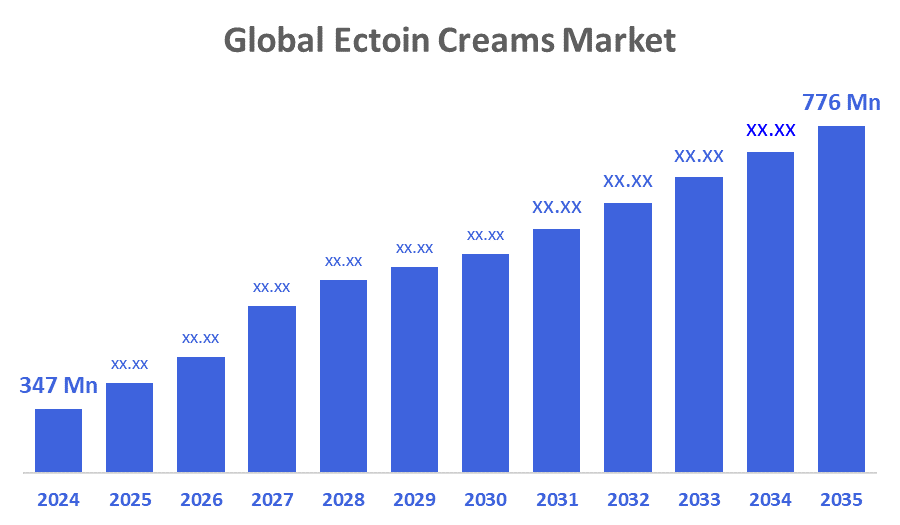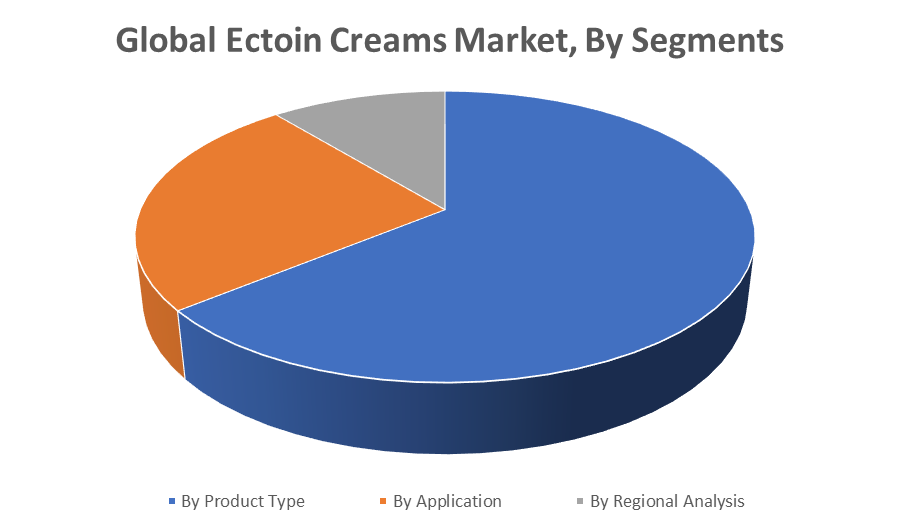Global Ectoin Creams Market
Global Ectoin Creams Market Size, Share, and COVID-19 Impact Analysis, Impact of Tariff and Trade War Analysis, By Product Type (Face Creams, Body Creams, and Hand Creams), By Application (Dermatology, Cosmetics, Pharmaceuticals, and Personal Care), and By Region (North America, Europe, Asia-Pacific, Latin America, Middle East, and Africa), Analysis and Forecast 2025 - 2035
Report Overview
Table of Contents
Ectoin Creams Market Summary, Size & Emerging Trends
According to Decisions Advisors, The Global Ectoin Creams Market Size is expected to Grow from USD 347 Million in 2024 to USD 776 Million by 2035, at a CAGR of 7.59% during the forecast period 2025-2035. Increasing consumer preference for natural and hypoallergenic skincare products, combined with rising incidences of skin allergies and dermatological conditions, is driving market growth.

Key Market Insights
- Asia Pacific is expected to dominate the ectoin creams market during the forecast period.
- Face creams segment leads in revenue share among product types.
- Dermatology applications hold the largest revenue share in the global ectoin creams market.
Global Market Forecast and Revenue Outlook
- 2024 Market Size: USD 347 Million
- 2035 Projected Market Size: USD 776 Million
- CAGR (2025-2035): 7.59%
- Europe: Largest market in 2024
- Asia Pacific: Fastest growing market
Ectoin Creams Market
The ectoin creams market focuses on products formulated with ectoin, a natural molecule known for its skin-protective, anti-inflammatory, and moisturizing properties. Widely used in dermatological treatments, cosmetics, and personal care products, ectoin creams help soothe sensitive skin, prevent dryness, and reduce redness. The growing demand for natural and sustainable skincare options and rising awareness about skin health, especially among aging populations and allergy-prone consumers, drives market expansion. Regulatory support for organic and safe cosmetic ingredients further boosts adoption. The integration of advanced formulation technologies enhances product efficacy and consumer acceptance.
Ectoin Creams Market Trends
- Increasing preference for natural and hypoallergenic skincare products among consumers.
- Growing use of ectoin in anti-aging and sensitive skin creams.
- Expansion of product portfolios by key players through R&D and partnerships.
Ectoin Creams Market Dynamics
Driving Factors: Rising consumer awareness about skin health and preference for chemical-free products
The ectoin creams market is primarily driven by growing consumer preference for clean, natural skincare products that avoid harsh chemicals. Increasing awareness about skin sensitivity, allergies, and long-term effects of synthetic ingredients has led to a surge in demand for ectoin-based formulations. Dermatologists also recommend these creams due to their anti-inflammatory and moisture-retention properties. With the rapid growth of online retail and health-conscious consumer segments, access to premium skincare has become more widespread. Furthermore, regulatory support and government-backed programs promoting organic and hypoallergenic cosmetics are creating a favorable environment for continued market expansion worldwide.
Restrain Factors: High production costs and limited raw material availability
Despite growing demand, the ectoin creams market faces significant constraints due to the high cost of ectoin extraction, which requires advanced biotech processes. This elevates product pricing, making it less accessible for cost-sensitive consumers, particularly in developing regions. Additionally, the supply of raw ectoin is limited, creating barriers for smaller and new market entrants. These supply chain issues are compounded by the presence of more affordable synthetic alternatives that appeal to price-conscious buyers. The lack of brand recognition and market penetration in underdeveloped regions further restricts growth and scalability for many companies in this segment.
Opportunity: Rising demand in emerging markets and technological innovations
Emerging economies such as India, Brazil, and Southeast Asian countries offer vast opportunities due to increasing disposable incomes, growing urban populations, and heightened interest in personal wellness. Consumers in these regions are becoming more aware of skincare quality and safety, driving interest in natural products like ectoin creams. At the same time, advances in biotechnology and formulation science are making ectoin production more efficient and cost-effective. Innovative products featuring multifunctional benefits (e.g., anti-aging, moisturizing, and UV protection) are gaining popularity. Strategic collaborations between research institutions and skincare brands can accelerate product development and market expansion.
Challenges: Regulatory complexities and consumer skepticism
The global ectoin creams market must navigate diverse and often stringent regulations related to cosmetic ingredients, labeling, and safety testing. Gaining approvals and certifications for natural skincare products can be time-consuming and costly, slowing down product launches. Additionally, despite growing awareness, many consumers remain skeptical about the effectiveness of relatively new ingredients like ectoin compared to traditional skincare compounds. This skepticism necessitates extensive marketing efforts and educational campaigns. Concerns over transparency, authenticity of "natural" claims, and product efficacy testing further complicate market positioning and brand trust, especially in regions with limited awareness of ectoin's benefits.
Global Ectoin Creams Market Ecosystem Analysis
The market ecosystem comprises raw material suppliers (natural ectoin producers), cosmetic manufacturers, dermatologists, retail and e-commerce channels, and regulatory bodies enforcing product safety and efficacy standards. Leading manufacturers focus on sustainable sourcing and innovation to meet evolving consumer demands. Partnerships between biotech companies and cosmetic brands drive new product launches and market penetration.
Global Ectoin Creams Market, By Product Type
What key advantages helped the face creams segment secure the largest revenue share in the ectoin creams market?
The face creams segment dominated the ectoin creams market with approximately 40% revenue share during the forecast period, primarily due to the growing demand for multifunctional skincare solutions that offer hydration, anti-aging, and environmental protection benefits. Ectoin’s strong protective and moisturizing properties make it highly suitable for facial care, especially in premium and sensitive skin formulations. Increasing consumer awareness about the harmful effects of pollution and UV exposure has further driven demand for ectoin-infused face creams.
How did the body creams segment maintain a strong presence with 28% of global revenue in the forecast period?
The body creams segment accounted for approximately 28% of the global ectoin creams market revenue during the forecast period, driven by increasing demand for full-body hydration and skin barrier protection, particularly in harsh or dry environmental conditions. Ectoin’s ability to reduce inflammation, retain moisture, and protect against environmental stressors made it a valuable ingredient in body care formulations. The segment also benefited from rising consumer interest in dermatologically tested and multifunctional body care products. Additionally, the growing popularity of self-care routines and wellness trends, alongside broader retail availability and product diversification across price points, supported strong market performance.
Global Ectoin Creams Market, By Application
Why was dermatology the preferred segment in the ectoin creams market, capturing 45% share?
The dermatology segment held the largest share, approximately 45% of the global ectoin creams market due to the growing demand for clinically tested, therapeutic skincare solutions. Ectoin’s proven efficacy in managing dermatological conditions such as atopic dermatitis, eczema, rosacea, and skin inflammation has positioned it as a preferred ingredient among dermatologists and healthcare professionals. Its anti-inflammatory, cell-protective, and moisturizing properties align well with dermatological treatments, particularly for sensitive or compromised skin.
What made the pharmaceutical segment a key contributor in the global ectoin creams market?
The pharmaceutical segment accounted for approximately 22% of the global ectoin creams market revenue during the forecast period, primarily due to the increasing recognition of ectoin as a medically beneficial active ingredient in the treatment of skin-related conditions. Its strong anti-inflammatory, cell-protective, and moisturizing properties make it effective for managing chronic skin disorders such as eczema, psoriasis, and allergic reactions. The segment also benefits from the growing demand for non-steroidal, natural alternatives in dermatological therapies, especially among patients seeking gentle and long-term skincare solutions.
Europe currently holds approximately 40% of the global ectoin creams market revenue.
This dominance is attributed to strong consumer preference for premium, natural skincare, alongside a well-established base of leading cosmetic and dermatology brands across countries like Germany, France, and the UK. Stringent regulatory standards in the EU around product safety and ingredient transparency further support the widespread adoption of ectoin-based creams. High awareness of skin health, coupled with a mature retail and e-commerce ecosystem, ensures consistent demand across both dermatological and cosmetic applications.
Asia Pacific is experiencing the fastest growth in the ectoin creams market and currently accounts for around 30% of global revenue.
With rising disposable income, urbanization, and increased awareness of skin sensitivity and anti-aging products, demand is accelerating, particularly in China, Japan, South Korea, and India. The region is projected to capture up to 35–40% of the market by 2035, driven by local product innovation, expanding middle-class consumers, and government support for domestic natural cosmetics manufacturing. Growth in online beauty platforms and influencer-driven marketing is also fueling regional expansion.
WORLDWIDE TOP KEY PLAYERS IN THE ECTOIN CREAMS MARKET INCLUDE
- Bitop AG
- Bloomage Biotechnology
- Evonik Industries
- Symrise AG
- Dr. Spiller
- Dermasence
- Biodroga
- Puri Pharm
- Others
Market Segment
This study forecasts revenue at global, regional, and country levels from 2020 to 2035. Decisions Advisors has segmented the ectoin creams market based on the below-mentioned segments:

Global Ectoin Creams Market, By Product Type
- Face Creams
- Body Creams
- Hand Creams
Global Ectoin Creams Market, By Application
- Dermatology
- Cosmetics
- Pharmaceuticals
- Personal Care
Global Ectoin Creams Market, By Regional Analysis
- North America
- US
- Canada
- Mexico
- Europe
- Germany
- UK
- France
- Italy
- Spain
- Russia
- Rest of Europe
- Asia Pacific
- China
- Japan
- India
- South Korea
- Australia
- Rest of Asia Pacific
- South America
- Brazil
- Argentina
- Rest of South America
- Middle East & Africa
- UAE
- Saudi Arabia
- Qatar
- South Africa
- Rest of the Middle East & Africa
Check Licence
Choose the plan that fits you best: Single User, Multi-User, or Enterprise solutions tailored for your needs.
We Have You Covered
- 24/7 Analyst Support
- Clients Across the Globe
- Tailored Insights
- Technology Tracking
- Competitive Intelligence
- Custom Research
- Syndicated Market Studies
- Market Overview
- Market Segmentation
- Growth Drivers
- Market Opportunities
- Regulatory Insights
- Innovation & Sustainability
Report Details
| Pages | 167 |
| Delivery | PDF & Excel via Email |
| Language | English |
| Release | Sep 2025 |
| Access | Download from this page |
